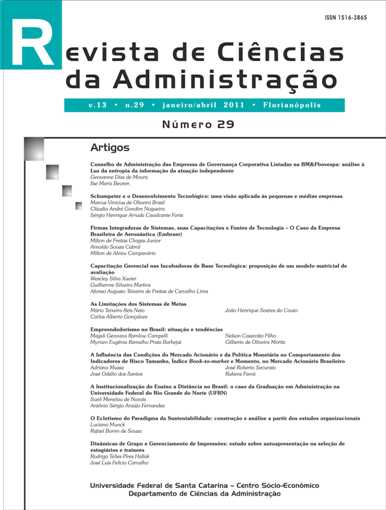Firmas integradoras de sistemas, suas capacitações e fontes de tecnologia – O caso da Empresa Brasileira de Aeronáutica (Embraer)
DOI:
https://doi.org/10.5007/2175-8077.2011v13n29p63Resumo
A dinâmica da inovação dos sistemas complexos tem sido tratada como uma categoria distinta de análise, uma vez que apresenta características muito diferentes daquelas dos sistemas de produção em massa e de processo contínuo. Sistemas complexos são bens de capital de alto valor agregado geralmente produzidos em pequenos lotes, através de alianças temporárias entre diversas organizações, porque uma única firma não consegue desenvolver toda a base de conhecimentos necessários para sua produção. O uso de fontes externas de conhecimento e componentes tem aumentado na estratégia competitiva das firmas – através da modularidade -, para fazer frente à crescente complexidade dos produtos, em termos de número de componentes e especialização de sua base de conhecimento relevante. A literatura sobre o assunto define firma integradora de sistemas como a organização que estabelece e lidera uma rede dos pontos de vista organizacional e tecnológico. Mesclando características positivas dos mercados e das hierarquias, estas redes ajudam a coordenação das atividades econômicas, especialmente aqueles com caráter inovador. Utilizando a visão baseada em recursos da firma como referencial teórico, o objetivo desta pesquisa é analisar, através de um estudo de caso, as capacitações requeridas para integrar conhecimentos, internos e externos, visando à coordenação de projetos e programas que atendam à evolução dos requisitos de seus clientes. O artigo propõe um modelo cognitivo estilizado que permite compreender o desenvolvimento de capacitações em integração de sistemas.
Downloads
Publicado
Como Citar
Edição
Seção
Licença
O autor deve garantir:
- que haja um consenso completo de todos os coautores em aprovar a versão final do documento e sua submissão para publicação.
- que seu trabalho é original, e se o trabalho e/ou palavras de outras pessoas foram utilizados, estas foram devidamente reconhecidas.
Plágio em todas as suas formas constituem um comportamento antiético de publicação e é inaceitável. RCA reserva-se o direito de usar software ou quaisquer outros métodos de detecção de plágio.
Todas as submissões recebidas para avaliação na revista RCA passam por identificação de plágio e autoplágio. Plágios identificados em manuscritos durante o processo de avaliação acarretarão no arquivamento da submissão. No caso de identificação de plágio em um manuscrito publicado na revista, o Editor Chefe conduzirá uma investigação preliminar e, caso necessário, fará a retratação.
Os autores cedem à RCA os direitos exclusivos de primeira publicação, com o trabalho simultaneamente licenciado sob a Licença Creative Commons (CC BY) 4.0 Internacional.

Os autores têm autorização para assumir contratos adicionais separadamente, para distribuição não exclusiva da versão do trabalho publicada neste periódico (ex.: publicar em repositório institucional, em site pessoal, publicar uma tradução, ou como capítulo de livro), com reconhecimento de autoria e publicação inicial neste periódico.
Esta licença permite que qualquer usuário tenha direito de:
Compartilhar – copiar, baixar, imprimir ou redistribuir o material em qualquer suporte ou formato.
Adaptar – remixar, transformar e criar a partir do material para qualquer fim, mesmo que comercial.
De acordo com os seguintes termos:
Atribuição – Você deve dar o crédito apropriado (citar e referenciar), prover um link para a licença e indicar se mudanças foram feitas. Você deve fazê-lo em qualquer circunstância razoável, mas de maneira alguma que sugira ao licenciante apoiar você ou o seu uso.
Sem restrições adicionais – Você não pode aplicar termos jurídicos ou medidas de caráter tecnológico que restrinjam legalmente outros de fazerem algo que a licença permita.


